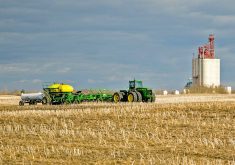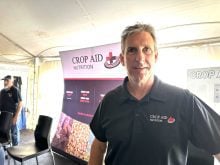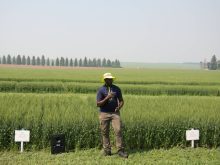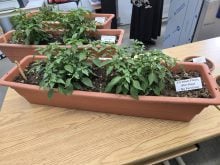Doug Wilton is curious about how much soil “wildlife” is in his fields.
That’s why the Roland-area farmer is participating in the “soilyourundies” demonstration launched during Soil Conservation Week in April.
“The Soil Conservation Council (of Canada) decided this would be something kind of fun and exciting and different to do in order to bring some awareness to the issue,” Marla Riekman, Manitoba Agriculture’s land management specialist, said April 18 on a sunny, but cold, windy day in Wilton’s zero-till field.
- VIDEO: Testing soil health with cotton underwear
Read Also

Manitoba boosts stake in cereals centre to $23.5 million
Premier Wab Kinew said the additional project funds will help ‘Trump-proof’ the provincial economy.
Riekman planted tighty whities in several Manitoba fields this spring. She will dig them up midsummer for an inspection.
“What we are trying to show is the microbial activity,” she said. “What happens is the microbes can’t tell the difference between cotton or a piece of crop residue. It’s all carbon to them. They are going to chew that up over time.
“There are times when all you have left are the seams if there is a lot of activity. It can be a tricky thing because it’s not just about the microbes. It’s also about the nitrogen because you need nitrogen in order to break down carbon.
“It’s to be taken with a little grain of salt as to what the actual results mean.”
Wilton hopes the underwear test will show his field has lots of soil microbes after 25 to 30 years in zero till.
“The soil is full of life and I’d like to see how lively mine is,” he said.
“Soil is a living thing and we need to watch that we have this to get the organic breakdown.
“I know I have lots of worms out there but it would be nice to see what works to get the organic material.”
When Wilton and his dad bought this parcel of heavy clay land in 1966, hard soil made it difficult to work. A plow would skim the top or go too deep. The previous owner routinely burned the crop residue following harvest.
“We felt we needed to do something with it so we put it down to alfalfa… and that helped a lot, but still the organic matter wasn’t up to where I’d like to see it,” Wilton said. “So I started zero tilling back in the mid- ’70s.
“I felt that through zero tilling I could get that organic matter back up to where I’d like to see it. I think I am achieving that.”
Salinity at the west end of the field also disappeared.
Tile drainage is increasingly popular with farmers in this area, but Wilton says this field doesn’t need it.
“I feel that my tile drainage is in the worms that develop in my soils,” he said. “I get a good soil-water mix. I don’t find puddling in the fields after a rain.”
Wilton was initially discouraged when he started zero tilling this field. The soil was so hard it wouldn’t cover the seed during planting so it had to be harrowed, he said. But with time the soil improved and continues to get better, Wilton added.
Not all Wilton’s fields are in zero till. He handles grain cornfields, which produce a lot of tough-to-manage residue, differently.
“We minimum till those fields through a rotation and we will drill directly into, say, a soybean field with our corn and then rotate oats back in there,” he said. “To get rid of that corn stubble we have trouble to zero till that.”















